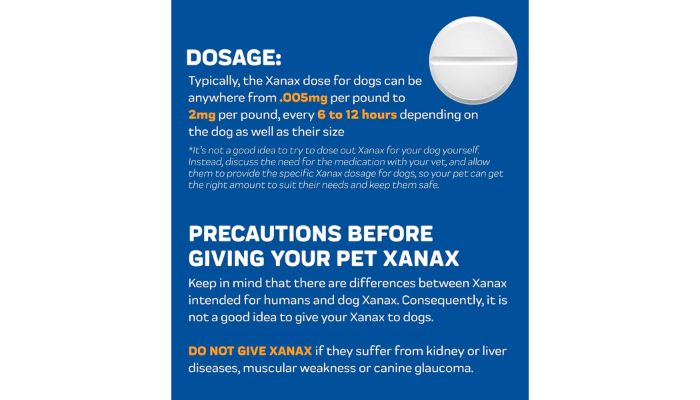You may think of Xanax as the little white pill that people take to reduce anxiety. But what about giving it to our furry friends? The answer is not so straightforward.
Xanax may offer some benefits, but it also carries risks. As you consider this decision, you’ll need to weigh the pros versus the cons, understand the proper dosage, and be aware of potential side effects.
Let’s explore the complexities of giving a dog Xanax and seek professional advice.
Understanding Xanax Use in Canines:

Frequently, you may wonder if it’s okay to give your dog Xanax. Xanax is a brand name for an anti-anxiety medication, alprazolam, that’s prescribed to humans to treat anxiety and panic disorders. Xanax works by targeting the brain’s neurotransmitters to reduce stress and calm a person’s nerves.
While it may seem like an ideal solution for managing dog anxiety, it’s important to understand the risk factors and behavioral impacts associated with giving your dog Xanax. It isn’t recommended to give your dog Xanax without consulting a veterinarian first. The side effects can be severe and long-term use may cause addiction or withdrawal. Additionally, the correct dosage will depend on the size and breed of your dog.
Therefore, it’s strongly advised to seek professional advice before giving your dog Xanax.
Pros and Cons of Utilizing Xanax for Dogs:

Despite the potential risks associated with giving your dog Xanax, there are also a few potential benefits that may make it an option worth considering. It may be used as an alternative treatment for conditions such as anxiety, aggression, and phobias. Pet safety is also a factor to consider, as it can help to reduce the risk of a dog becoming injured or hurting someone else.
Here are some pros vs. cons to consider:
Pros:
- Alternative treatment option
- Reduced risk of harm
- May help with behavioral issues
Cons:
- Possible side effects
- Potentially harmful if used incorrectly
- May not be suitable for all dogs
Ultimately, it’s important to consult with a veterinarian if you’re considering giving your dog Xanax. They can provide the best advice for your pet’s particular needs and help to ensure their safety.
Dosage Considerations for Dog Xanax:

When giving your dog Xanax, it’s important to adhere to the prescribed dosage. This is to ensure your pet doesn’t experience any negative effects from the medication.
You should always consult your veterinarian prior to administering Xanax to your pet, as there may be medication interactions with other drugs your dog is taking. Additionally, there are dosage guidelines specific to your pet’s weight, breed, and health condition that should be carefully considered.
It’s also important to note that Xanax should only be used as a short-term solution to anxiety or other behavioral issues and shouldn’t be given as a regular part of your dog’s routine.
With these considerations in mind, you can safely give your pet the medication they need.
Potential Side Effects to Consider with Dog Xanax Use:
While it’s important to follow the dosage instructions provided by your vet, it’s also critical to be aware of potential side effects your dog may experience when taking Xanax.
In some cases, dogs may experience:
- Drug interactions, such as with other medications they may take.
- Behavioral effects include hyperactivity, reduced appetite, or changes in sleep patterns.
- Physical symptoms, like shaking, dizziness, and vomiting.
It’s important to watch out for any changes in your dog’s behavior when they take Xanax. If you notice any of the above symptoms, contact your vet right away. Never increase the dosage without consulting a professional, as this could cause further complications.
Professional Advice:
It’s always best to consult a vet before giving your dog Xanax. Professional advice is important because it takes into account potential drug interactions and medical research that can be used to ensure the safety of your pet.
It’s important to never give your dog medication without a veterinarian’s approval, as it could result in serious health concerns. Additionally, you should be aware of any potential side effects and be ready to treat them if they occur. Be sure to monitor your pet closely and look out for any signs of distress.
With the help of your vet, you can make an informed decision about whether giving your dog Xanax is right for them.
Frequently Asked Questions:
No, Xanax is not safe for puppies. Dog behavior can be affected by pet anxiety, and this medication should not be used to treat it in young animals. Consulting a veterinarian is the best way to address anxiety in puppies.
Metaphorically, it’s like playing fetch: Xanax quickly relieves anxious behaviors in dogs in as little as 15 minutes after administering. Along with behavioral training, Xanax is an effective tool for managing canine behaviors.
Yes, there are alternatives to Xanax for dogs. These include natural calming methods and medications with fewer side effects. It’s important to discuss the best option with your vet.
Yes, xanax can be habit-forming for dogs. It’s important to follow dosage guidelines and monitor for potential side effects.
Yes, xanax is available in a chewable form for dogs. However, it’s important to consider the potential side effects and follow the dosage levels recommended by your veterinarian.
Conclusion:
Giving a dog Xanax is a decision that should be taken very seriously. While it may have its benefits, it’s important to remember that the side effects can be serious.
It’s best to consult a veterinarian before making such a decision, as they can provide individualized advice based on your pet’s medical history. Ultimately, it’s a decision that shouldn’t be taken lightly.
As the old saying goes, ‘An ounce of prevention is worth a pound of cure.’ Taking the time to do your research and consult the right professionals can help you make an informed decision that will benefit both you and your pet.

Hey there, I’m Janet Brooks, a dog-loving student from California. I’m all about helping pups in need, especially those without homes. Me and my awesome friends work together to give shelter and love to stray dogs. Oh, and I also write blogs about dogs to share helpful info.